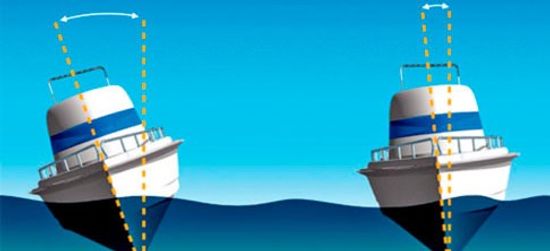Fin or Gyro: Which is the Best Way to Stabilize Your Yacht?


Last Updated on September 23, 2023.
One of the most frequently asked questions I get at boat shows and with talking to potential boat owners is: What’s the difference between fins or gyro and which is better?
Unfortunately, there isn’t a clear-cut answer to this question, and like everything else, if you ask 5 people, you will get 5 different answers.
When it comes to yachting, stability is key. A stable yacht provides a comfortable and safe environment for passengers and crew. However, achieving stability can be a challenge, especially when dealing with rough seas and changing weather conditions. Two popular methods for stabilizing yachts are fin stabilization and gyro stabilization.

Gyro stabilization works by utilizing the principles of angular momentum and torque. When a spinning wheel gyro is mounted in a gimbal system, it will maintain its orientation in space, resisting any attempts to move it. This means that when a yacht starts to roll, the gyro will resist that motion, generating a torque that acts in the opposite direction. The result is a reduction in roll and an improvement in stability.

Fin stabilization involves the use of underwater fins attached to the hull of the yacht. These fins work by creating lift, which counteracts the rolling motion of the yacht. Fin stabilization are either electric or hydraulic.
Roll stabilization is the process of reducing the rolling motion of a yacht. This motion is caused by the forces of waves and wind acting on the yacht’s hull. Roll stabilization can be achieved through the use of fins or gyroscopes.
Let’s start by saying this; both systems work very well, and you will have a better boating experience regardless of which system you choose, or which solution may already be installed on a vessel you are considering. The technology is proven and is only getting better.
It has been my experience that smaller vessels, let’s say, under 60’ seem to work better with a gyroscopic stabilization system, and vessels over 60’ seem to perform better with FINS. (There are many factors, and A LOT of physics involved. Center or gravity, vessel length, hull shape, and weight, just to name a few.)
Let’s explore why larger vessel react better to fins: FINS are external and react to changing conditions and force from the water, and because water is zero compression, it only makes sense that the more force (water pressure) applied to the FINS, the better they will react, and if your FINS are sized correctly, the FINS will always be scalable and do a fine job.
A gyro on the other hand, is a fixed internal piece of equipment and has predetermined limitations on how much force the gyro can counter act, and this is probably why you see multiple gyros installed on bigger boats. I have seen as many as four gyros installed on vessels over 100’, and that’s a lot of equipment to maintain. The most important factor when considering a gyro is sizing the gyro correctly. The length, weight, and center of gravity of the vessel are all key factors. If in doubt, always go one size up, you can never have too much stability.
Another common question relates to zero-speed or at anchor stabilization. There is a lot of misinformation out there about which systems offer zero-speed stabilization, and the fact is, almost all new stability systems offer zero-speed and underway stabilization in the same package. The consensus among people that I have spoken to, and my personal experience goes something like this: All things being equal, and both systems are sized correctly, the gyro will slightly outperform the fins at anchor, and the fins will slightly outperform the gyro underway. Again, there are a lot of physics involved, and I am NOT a scientist, but these are general observations I have made from first-hand experience and speaking to peers in the industry.
Retrofitting
When considering adding a stability system to your existing vessel, a gyro is usually the easiest way to go, assuming you have the required space, and power requirements. Don’t forget, a gyro allocates valuable Kw’s from your generator.
Maintenance Costs
After three decades in the industry, I have seen very little evidence that one system costs more to maintain than the other. When installed correctly, a quality brand product such as a Seakeeper Gyro, or a Side Power FIN will be relatively trouble free if you perform the routine maintenance that is suggested by the manufacturer.
In conclusion, choosing between fin or gyro stabilization systems ultimately depends on the specific needs and priorities of the yacht owner. For those who prioritize comfort while at anchor, zero speed stabilization is a crucial feature to consider. On the other hand, those who prioritize speed and efficiency may opt for appendages such as side-power vector fins.
Safety onboard is a top priority for families and boat owners alike. Both fin and gyro stabilizers provide roll stabilization, which greatly reduces the risk of accidents and injuries.
Set sail without worrying. Get Wave App for yacht care – download now: https://wavemarinegroup.com/wave-app/

Commodore of Deals & Keels at Wave Marine Group
Born and raised in the U.K. to a sailing enthusiast family, James has a lifelong connection to the water. He combined his passion for yachting with his expertise in technology, rising to Director of Information Technology at Lazzara Yacht Corporation. After achieving record sales at Sunseeker Florida, he later co-founded Wave Marine Group, a marine-tech company, with business partner Anthony Burns.